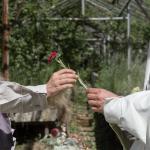“Well, bless ye little heart, honey, ye say ye is wan’ me to tell ye ‘bout how de people lived way back dere in slavery time. Honey, I dunno wha’ to tell ye cause I ain’ never been treated no ways but good in my life by my Missus.”1 These are the supposed first words spoken by Mom Hester Hunter, a maternal eighty-five-year-old former slave from Marion, South Carolina, to her interviewer, Annie Ruth Davis, a white Works Progress Administration (W.P.A.) employee. Davis interviewed Hunter on three occasions between May and October 1937. Through these three interviews, Davis and Hunter engaged in lively discussion, with the latter recalling many fond, personally emotional memories about her mistress, Sara Davis Bethea. At the conclusion of the first interview Hunter revealed, “I know my Missus gone to Hebbun, honey, en I hope se restin’ dere.”2
Mom Hester Hunter remembered her mistress consoling her in times of sorrow, accompanying her to the slave graveyard to pay homage to the deceased, ensuring that she always had well-made clothes and a clean bed, sharing meals with her, taking trips to town with her, and gently instilling in her a sense of morality. During the second interview Hunter revealed just how well she thought of her former mistress, “Yes, mam, I love my old Missus better den I ever love honey an flour bread cause she was a dear old soul.”3 While Hunter shared a trove of memories with Davis, she spoke at length about the special times she shared with her mistress on Sundays in church, expressing gratitude for the ways by which evangelical Christianity had enriched her life. Hunter forever associated her religious identity and beliefs with her mistress:
My God, child, people never know nothin but to go to church on de big Sunday in dat day en time. No, mam, dey know dat dey Massa rule en didn’ nobody have no mind to question nothin bout it. My Old Missus was a dear old soul en she would see to it dat all her niggers wash en iron en cook on Saturday cause she never allow no work gwine on round whe’ she was when Sunday come, be dat she know bout it. I remember my old Massa en Missus used to ride to church in dey big black carriage en dey always would carry me en Bob her brother right dere in de carriage wid dem somewho another. Stuff us down ‘tween de seats somewhe’. I recollects just as bright as de stars be shinin old Missus would carry me en Bob to de same little seats we been sit in every Sunday en den she en old Massa would go to dey certain pew in de front part of de church.4
Later recalling the importance of white-directed Christian instruction in her life and the lives of other slaves on the Bethea plantation, Hunter remarked, “Dat been a mighty good thing, child, been a mighty good thing. Honey, it been de rule to follow what de Bible say do in dat day en time en now it seem like de rule must be, do like you see de other fellow is doin.”5
Hunter’s comment about emancipation, a day she “hates to think bout,” further suggests an emotional bond with her mistress.6According to Hunter, at the end of the Civil War, Mrs. Bethea informed her slaves that they were free but allowed them to remain on the plantation if they so desired. Hunter could not imagine leaving her mistress. She told her W.P.A. interviewer that her mistress was her “white mammy en I stay dere long as she live too. Didn’ want no better livin den I was gettin right dere. It was a Paradise, be dat what I calls it.”7 This illuminates an especially close mistress-slave relationship—one obviously influenced by the scriptural and theological traditions of evangelical Christianity—as remembered many decades later by one former bondswoman. It is an idealized portrait of antebellum slavery that would support any southern apologist’s contentions about the benevolent nature of the institution. Such a portrayal though does not align with most scholarly descriptions of mistress-slave relationships.
This essay scrutinizes former slaves’ memories of religious education, including Mom Hester Hunter, as well as those of the former slaveholding women who imparted such instruction and values. It examines post-bellum memories of mistress-slave relationships, specifically as they related to the teachings of evangelical Christianity. Thus, what follows is not a discussion of slave religious education presented by slaveholding women as it occurred. Rather, this article presents an analysis of the politics of the memories of slave religious education by both former slaveholding women and former bondspeople. Most distinctively, this essay argues that there was a partial convergence of white and black narratives of the past during the late nineteenth and early twentieth centuries, and in so doing, it assesses such narratives vis-à-vis the realities of the post-bellum South. Alternately stated, this article contends that the memories of former slaveholding women and former bondspeople were both similar and very much products of their time.
Read the rest here














